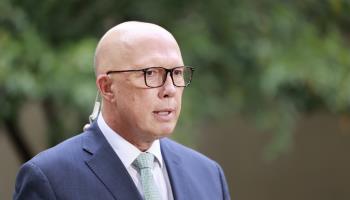Labor and the opposition coalition are losing ground to smaller parties and independents ahead of the May 3 election
Opinion polls give the governing Labor Party a slight lead over the conservative Liberal-Nationals coalition ahead of the May 3 election. Both Labor and the coalition are losing ground to smaller parties and independents, who look set to take one-third of votes and could prevent either from securing a majority. Recent changes in electoral boundaries and a significant number of non-aligned younger voters have added to uncertainty about the outcome.
What’s next
Subsidiary Impacts
- The imposition of US tariffs has focused attention on economic management, giving an advantage to Albanese and Labor.
- Dutton’s misreading of the issues that resonate with voters will cost the coalition votes in crucial marginal constituencies.
- Both major parties are losing primary voting support, leaving them reliant on preference deals with smaller factions and independents.
Analysis
On May 3, voters will elect all 150 members of the House of Representatives and half of the 72 Senate seats. Senators have six-year terms, compared with three years for a House member.
Either Labor or the coalition has formed almost every federal government since Australia gained independence in 1901, but both groups are in a perilous position:
- Now holding 78 seats, Labor will no longer have a majority if it loses just three, which would happen with an electoral swing of less than 1% away from the party. In 2022, it needed a swing of 3.7% to win.
- The coalition alliance has only 57 seats and needs a swing of 5.3% to gain the 19 seats it needs to win a majority, and 3.6% (a gain of eleven seats) to lead a minority government.
Opinion polls have Labor winning 51-53% of votes and the coalition 47-49% on a two-party basis, meaning the final tally after ballots cast by voters whose first preference was for one of the smaller parties have been redistributed. However, independents and minor parties took 16 seats away from the larger parties in 2022, and these groups still hold the balance of power.
Greens and independents
The Australian Greens would win 13.0% if an election were held now, slightly up on 2022, and the conservative populist One Nation party 5.5%, also up slightly. Other small parties would claim 4.0%.
Originally an environmental lobby, the Greens now promote themselves as a left-centre alternative to Labor.
The Greens are offering to support a Labor minority government
Collectively backed by 10.5% of voters in the most recent opinion polls, independent candidates have no political affiliations but often back the same causes, notably environmental concerns. Most emerged in the 2022 election, when there was a backlash against the coalition government in some inner-city seats (see AUSTRALIA: Labor lead narrows as election approaches – May 19, 2022).
Preference deals will be crucial
Given the diffuse nature of political affiliations, the outcome is unlikely to be decided by primary votes, which show candidates’ initial positions after the first ballot count. Next comes a system of preference allocations, in which votes from the bottom candidates are shifted to those still in contention, either by voters directly or as the result of pre-arranged deals between parties.
Primary support for Labor has sunk to about 32%, while the coalition’s vote is around 35%. However, using data from 2022, the voting picture begins to change once preferences are applied:
- Labor will gain 53.5% on a two-party basis if preferences remain the same as last time. It won in 2022 with 52.1% but needs 54.2% in 2025 to allow for possible swings to minor parties.
- The coalition’s two-party vote will decline to 46.5%, well below the level it would need to win government. A two-party edge of 54.2% is needed to ensure a majority win.
Most parties have not yet declared preference choices, but political alignments are evident:
- The Greens will give their preferences to Labor to ensure the coalition does not win and have offered to form an alliance with Labor in a minority government if there is no clear majority.
- Candidates from smaller conservative parties including One Nation will take some votes from the coalition, but they also usually pass votes to the coalition after being eliminated.
- Partly financed by climate lobbies and heavily vested in social causes, independents will leverage their preferences for future policy pledges, but have traditionally had a bias towards Labor.
Political allegiances being tested
Labor and the Liberals have both moved towards the political centre in recent years, blurring the ideological and class lines that had defined their agendas and loosening the loyalty of voters. Frustrations over weak leadership have driven many to minor parties.
Demography and redistribution
Demographic changes have also made it more difficult to predict electoral outcomes. Redistribution, the independent process of redrawing constituency boundaries to keep their population size roughly equal and which took place most recently in 2023, has abolished some and and altered the political profile of others. As a result, Labor will lose two marginal city seats at this election but may gain two others, while the coalition loses one seat.
Younger voters
People aged 18-44, who surveys suggest are less trustful of political norms and more impatient for change, will this year become the largest voting bloc for the first time. Dutton has most to lose from this shift, as only 25% of young people say they support the coalition.
Gender gap
Voters are increasingly divided on gender lines, with men more likely to back the coalition, citing Dutton’s tough image, and women backing candidates who campaign on social issues, particularly independents.
Dutton pays for flawed strategy
Dutton had built up his political position during 2024, overtaking Albanese as the person voters would most like as prime minister, and having significantly better job approval than Albanese as recently as February. However, the latest YouGov poll, released on April 4, has his satisfaction rating at minus 15, its lowest ever, compared to minus 6 for Albanese.
Borrowing from US President Donald Trump, Dutton began the election campaigning for small government, with a pledge to remove 41,000 civil service jobs and make sharp cuts in public spending. The identification with Trump, whose tariff policy has made him increasingly unpopular in Australia, has been costly for the coalition.
Albanese has proved more astute at identifying voter concerns
Albanese has been more astute in identifying issues that most resonate with voters. Almost 75% list high living costs as their main concern, follow by housing (37%) and healthcare (27%). Labor is offering cheaper medicines and housing rebates; Dutton has matched the medicines pledge, and will allow the use of pension funds to buy homes.
Climate change debate has been muted so far, especially compared to 2022. Dutton is now playing down earlier plans to reduce emissions by introducing nuclear power with seven new reactors (see AUSTRALIA: Nuclear scepticism will persist – April 11, 2024).
Trump’s 10% tariff on Australian goods, and penalties on some minerals, have highlighted the respective economic policies. Dutton is at a disadvantage, as Albanese has already announced initiatives to respond, including a new fund offering interest-free loans to help exporters find new markets, a Buy Australian campaign and strengthened anti-dumping measures.

Opposition leader Peter Dutton speaks to the media after last month’s budget speech, Canberra, March 26, 2025 (Hilary Wardhaugh/Getty Images)
Analyst

Dr Giles Alston
Deputy Director & Senior Analyst,
North America

